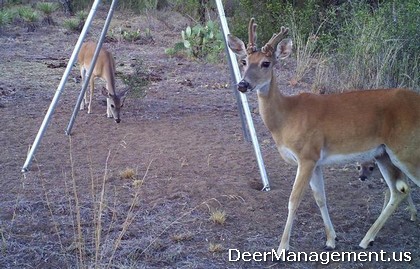What is a Cactus Buck?
Question: Late last December, one of the guys on my deer hunting lease in located in Brown County, Texas, shot a good looking buck and the antlers were still in full velvet. He called the deer a cactus buck, but the deer did not have testicles. Also, I know that bucks usually shed their velvet in late summer, but this one did not. Would this cactus buck have shed his antlers or not in the spring?
Answer: It sounds like the guy you hunt with did in fact shoot what is referred to as a cactus buck. These bucks are not rare, but they are not abundant either. This “cactus” condition in whitetail bucks that results in antlers remaining in velvet and continuing to grow beyond the normal velvet-losing time of the year. The condition that causes a deer to be a cactus buck is called hypogonadism. It can occur just about anywhere in the whitetail’s range, but is common in areas with granite soils.

Cactus Bucks in Central Texas
The buck your friend shot also has cryptorchidism, which is a condition in which the testes fail to descend from the abdomen. This deer likely was impacted while still in the womb, as this condition is common in parts of Central Texas. It’s believed that diet of gestating females contributes to cryptorchidism in fawns.
The condition impacts testosterone levels, which regulate antler growth and development. In the most extreme cases, the testicles of cryptorchid bucks remain in the abdominal cavity and never descend into the scrotum. As a result, the normal production of testosterone is reduced and the normal antler cycle is destroyed.
In most cases, the cactus buck abnormality occurs naturally, without injury—these deer just do not develop properly. However, the same effect can result when a normal deer that suffers from testicular damage. A buck could function normally for several years then incur some type of testicular injury and then become an injury-created cactus buck for the rest of his life.
Cactus Bucks and Low Testosterone
In normal whitetail bucks, decreasing photoperiod during the late summer causes a rise in testosterone levels. This spurs the velvet shedding process. During the following spring, as days begin to get longer and photoperiod increases, a normal buck’s testosterone level drops. This initiates the antler shedding process.
This is not the case in these stag bucks. In cactus bucks, because they lack functioning testes, this cycle does not occur. Instead, cryptorchid bucks remain in velvet and continue to grow indefinitely, often developing antlers with numerous abnormal points, giving them the descriptive name, cactus buck.